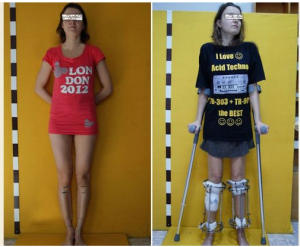Most people who are in the online community who discuss the issues and problems related to being short might sometimes wish that their own children (or future children) will be taller than them so that they don’t have to go through the same kind of ostracizing that the parents got when they were younger due to their short stature.
There was even one thread on an old reddit post which turned viral because a wife suggested to her husband (immediately after sex) that she would prefer to have a child with another man instead of him because her husband was short statured. She was afraid to make her future sons or daughters short because they would have it harder in life. Based on what I have read from the evolutionary biology books like The Selfish Gene by Professor Richard Dawkins and The Red Queen by Matt Ridley and Sperm Wars by by Robin Baker, that action is basically the worst suggestion a heterosexual female can tell her chosen lifelong male partner. Genetic infidelity or the idea of using one’s hard earned resources to take care the genetic offspring of another man is probably the worst offense a normal male could ever be asked to do. Humans as animals are evolutionary programmed to resist this idea on the most instinctual level.
Well, there is a type of genetic engineering revolution that is going on in the biology, genetic, molecular biology, and biomedical research labs around the world right now that would signal the possibility that we may one day be able to design a person from birth to give them the qualities that we desire. No more can a woman (or man) complain to the world that the reason they don’t want to mate and be with a potential romantic partner for the long term is because of a perceived genetic lottery loss for their future offspring. When we think about all the times when a short female refused to date, marry, or mate with a short male and used the excuse that she just didn’t want to have short children, we realize that this extremely primal/instinctual desire will no longer be worried over.
This gene editing technique is going to change everything. It is a disruptive technology (as coined by Clayton Christensen) in every sense of the word. It is not going to be immediate and you won’t find super-babies next year, but it has made the idea of “super-babies” an almost guaranteed certainty.
This CRISPR-Cas9 gene editing tool has been so revolutionary that the use of it within the labs around the world has spread like wild-fire. It is probably the biggest Biotech Disruptive Innovation that will come about this century. Where gene editing was extremely hard and inaccurate before, this tool which was only developed in the beginning of this decade has made gene editing extremely easy.
This tool is going to change the field of biology, genetics, and agriculture completely. And that is not an exaggeration. Most researchers from MIT to Caltech are talking about the implications of this technique, which is so simple and non-technical that a BioHacker in his DIY Lab in his/her garage can use it.
There was news that came out about this team in China which has been using the technique already on embryonic cells and the news has shocked quite a people in the biology/genetics world.
If the readers can remember the basic premise of the movie Gattaca, with Ethan Hawke, and one of the few instances where we get a glimpse of a person having limb lengthening surgery performed on them in a blockbuster movie, this technique is basically the key that could very well unlock the door to that world. I am not here to judge whether a potential future where people will be judged solely on their genes is a dystopia or not.
This technique is going to let expectant parents choose the features of their child that they want. We are reaching the level of Science Fiction now.
While genetic manipulation is not going to work on an adult, unless they are going for a radical total cell transplantation with genetically modified cells ala artificial dialysis machine style (where you pump the ordinary cells out of the body and have new gene therapy treated cells flushed into the body), this technology in a few decades will change everything on how we view natural human babies.
How would the average couple in the year 2050 feel knowing that their more well-off neighbor couple can afford the extra $200K treatment to change the phenotypically traits of their unborn child to be 3-4 inches taller and 20-30 IQ points higher? That type of advantage leads to so many bioethical questions for the researcher scientists today.
Of course, we should maybe take a step back and remember the fact that height is not one of those traits that is controlled by one gene. It is not something like the color of one’s eyes or whether one has a widow’s peak or not. Height is quite complex.
It turns out that height is controlled by at least hundreds, if not thousands of genes. The closest we have come to finding one gene that has a profound effect on height was the HMGA2 gene (HMGA2 is confirmed to be associated with human adult height.) From another source, we find out that “…Adults with two copies of the height-increasing version of the HMGA2 variant are on average 0.8 centimeters taller than adults carrying two copies of the other version”. ) Sure, 0.8 cm does not seem like that much, but it is almost 1 cm, and 1 cm will over time become noticeable, when you then combine the effects of HMGA2 with the GDF-5 Gene. From the same source, we learn that “…pointed to a second gene, GDF5, of which the average height difference between genotypes is 0.4 centimeters.” Since most of the world is based on the metric system, and most people state their height to the 3rd digit, that extra centimeter can mean quite a bit.
I personally have heard enough stories of people in China and India being rejected from their dream jobs because they were off the job height requirement by 1 cm.
We know based on just looking at some common organizations like the US based NBA basketball organization that there are families which have the gene for tall stature. There are many brothers, twins, and father-son combos we find in the NBA. Clearly someone like Yao Ming has that genetic trait. It would not take that much to get blood samples from those who have familial/genetic propensity for tall height, and slowly over even a decade figure out what are the other 500+ genes which when expressed properly, would cause a genetically engineered baby to be 4-5 inches taller than through the natural path.
So is it that big of a deal that some potential mother or father would want to spend hundreds of dollars to alter the genetic material of their baby to be taller? I believe that some people will care that much about it. They would gladly open their wallets and pay for that type of treatment. The world is becoming more and more competitive, especially for the younger generation of kids, who are now competing on the global level. The young Chinese prodigy will be competing against the young Indian prodigy in 30 years – a billion vs another billion. People will do what they can to give their offspring as many advantages as they can for later life success.
I wrote about this technology before in the post “CRISPR Technique with Cas9 Enzyme To Alter Hereditary Traits Easily” back in 2013 but in the span of 2 years, everything has changed.
For the love of god, I am begging the readers of this website to read this article from the MIT Technology Review magazine – “Who Owns the Biggest Biotech Discovery of the Century? – There’s a bitter fight over the patents for CRISPR, a breakthrough new form of DNA editing.”






